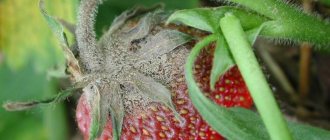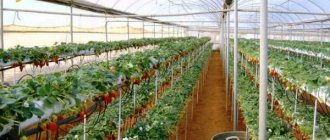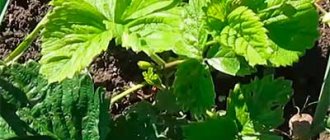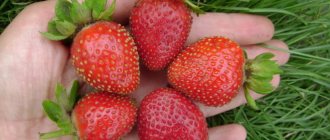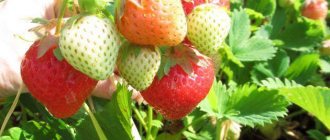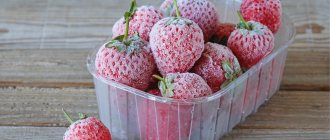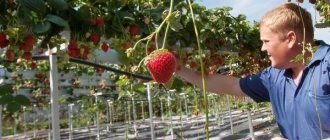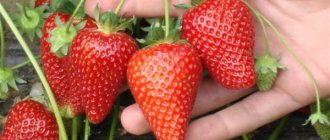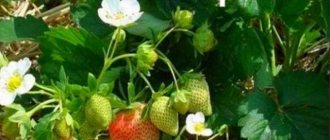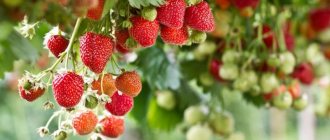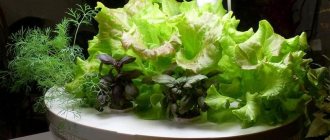Category: Hydroponics Reading time: 9 min · Views: 5,478
Hydroponics is a modern way of growing berries and vegetables. This method is more productive and less expensive, especially for everyone’s favorite strawberries. The usual beds in the garden are replaced by hydroponic strawberries. What is it, and how can you organize such a system yourself? Let's talk about the new method in detail.
Growing strawberries hydroponically
Hydroponics is a technology for cultivating plants in an artificial environment, on a specially prepared substrate in conjunction with a nutrient solution. The method got its name from the words of ancient Greek origin “hydro” - water and “ponos” - work. Hydroponic strawberries receive everything they need for successful flowering and fruiting. Growing garden strawberries using the hydroponic method allows you to get a good harvest all year round.
The growing technology is simple, there is nothing complicated in it, but caring for the plants must be regular.
Strawberry varieties suitable for growing hydroponically
Depending on the variety of strawberries that are grown, the berries will ripen 4-5 weeks after the first flowers open. The best varieties for hydroponic propagation are:
- Gorekla;
- Mount Everest;
- Gigantella;
- Vola;
- Fresco;
- Bagota;
- Yellow miracle;
- Olvia;
- Douglas.
Theoretically, any variety can be grown using this method, but it is better to start with already tested varieties, and then move on to others. Growing from seeds will take 2 – 3 years to reach maturity, so it is better to give preference to seedlings. Ideally, the seedlings that are selected should have flowers or at least have buds.
How dangerous are Alternaria and downy mildew, and how to treat diseases in plants?
Information on the conditions for growing and propagating indoor coleus at home is on this page.
Features of growing garden and indoor geraniums: .
System Description
A hydroponic setup looks like this. This is a large container filled with a nutrient solution, saturated with useful substances. The liquid circulates inside the hydroponic system using pumps. Strawberry bushes are planted in glasses or pots filled with substrate. There are the following types of hydroponic systems:
- passive;
- active.
In the first case, no pumps or mechanical devices are used. These methods include wick systems or the nutrient layer method. You can learn more about the varieties of hydroponics in the article: “What is hydroponics.” In the second case, fluid circulation is ensured by the continuous operation of pumps.
Pros and cons of technology
Hydroponics, as a method of progressive crop production, has advantages and disadvantages. Growing strawberries hydroponically is a simple process. However, before you start breeding plants, you need to make an accurate calculation, calculate income and expenses, and assess possible risks. The advantages of the technology are worth noting:
- saving space;
- no need for daily watering;
- no dependence on weather conditions;
- resistance to fungi and pests;
- high productivity;
- rapid ripening of strawberries;
- environmental friendliness of the product.
In addition to the advantages, this technology has some disadvantages. In particular, it is worth noting such disadvantages as constant monitoring. Plants grown hydroponically require daily care. It is necessary to maintain the level of nutrition and its composition, the level of water consumption, substrate humidity and light conditions. Constant monitoring may seem tedious to a novice gardener. But the result justifies the effort, especially since all this can be done under the control of simple automation.
What is the essence of hydroponics?
The simplest analogue of technology is the ancient Gardens of Babylon, classified as one of the famous seven wonders of the ancient world. But the method proposed by scientists these days is more efficient and has automated systems. The essence of the technology is growing plants on special artificial substrates, without the use of soil.
The culture is placed in special conditions, providing an optimal growing regime:
- warm;
- lighting;
- power supply;
- moisture.
On a note! The term was introduced into science by US biologist William F. Guerrike (University of California). He tried out the hydroponic pool method in the 1920s.
Nutrition occurs not at the expense of the soil, but due to the intake of nutrients by the roots from solutions supplied to the substrate. The appearance of weeds and soil depletion are excluded, there is no need to constantly apply fertilizers or water the plantings.
If in open ground the harvest of garden strawberries depends on weather conditions, agricultural technology, soil fertility, and pest activity, then with hydroponic technologies most problems disappear.
"Pros" of hydroponics:
- complete control over plant development;
- ease of cultivation;
- environmentally friendly products;
- saving water;
- easy care (no weeding, loosening);
- rapid growth of bushes;
- high yields subject to proper agricultural technology;
- the ability to grow berries in any season and even all year round;
- high profitability, which is why hydroponic systems are often used for growing strawberries on an industrial scale (a profitable line of business).
Among the disadvantages, they note the need to maintain a certain regime of humidity, temperature, and lighting. It is important to use only high-quality nutritional composition, special substrate and varieties suitable for hydroponics. Any violation leads to slower growth and even loss of seedlings.
Pros and cons of technology
Let's start with the positive points:
- Economical. No watering needed. The berry receives all the required volume of water from the nutrient medium. There is no evaporation as with conventional irrigation. The nutrients contained in the solution also act “targeted”, and do not go aimlessly into the soil in uncontrolled quantities.
- Productivity. With minimal consumption of moisture, fertilizing and space, you can get the highest possible yield.
- Productivity does not depend on the time of year, climate, weather conditions, soil fertility and other external factors.
- Environmental friendliness. With the right substrate, you will not need to use dangerous herbicides and pesticides. The fruits do not accumulate salts of heavy metals, radionuclides and other harmful substances that can enter the plant through the soil.
- Vitality. Seedlings are not susceptible to diseases caused by soil fungi and pests.
- There is no need to work with the soil, constantly loosen the soil and fight weeds.
- The ripening time is reduced by 2-3 times.
- Ready-to-eat plants are easy and quick to collect. There will always be fresh herbs, vegetables and berries on the table, freshly picked from the garden.
- Aesthetic pleasure from a green corner of the house and fresh strawberries throughout the year.
Despite all the listed advantages, this technology also has its negative features, which you also need to know about:
- There is a high risk of making mistakes when preparing a hydroponic solution. Any inaccuracy can lead to the death of the entire plantation, and the process will have to start all over again.
- The need to maintain constant temperature, humidity and light conditions.
- Each type of plant will require an individual selection of nutrient composition.
- The use of hand pollination is a labor-intensive process.
- Tangible financial costs at the initial stage.
- Constant energy consumption.
- This method is not suitable for irresponsible gardeners. It requires constant monitoring, scrupulousness, patience, punctuality and accuracy.
Drip irrigation
Drip irrigation system is a popular type of hydroponic setup. The essence of the method is that the nutrient solution is supplied from the container using electric pumps strictly on schedule directly to the roots of the plant. The substrate is evenly saturated with moisture, which is very useful for strawberries. There are two types of drip installations:
- reversible;
- irreversible.
In the first option, the nutrient solution is reused after watering. In the second, the solution is applied only once, and possible residues are disposed of or completely absorbed by the roots of the plant.
The drip irrigation system is simple and easy to use. You can buy it in the store. Those who want to experiment with hydroponics can build the installation themselves from available components. The simplest structure can be built from a PVC pipe in which glasses with seedlings are placed. The pipes are connected with elastic hoses, and plugs are installed on the sides. More details about such a system can be found in the article: “Homemade hydroponic installation. Drip irrigation system."
To avoid mold and mildew, the system must be cleaned regularly.
What technology to use?
For strawberries, you need to prepare a place for growing and choose hydroponics technology. At home, you can use the DWC method, deep water culture. The plant develops its root system well.
When using this technology, they are constantly in a nutrient solution. You can assemble hydroponics for strawberries with your own hands from scrap materials.
- Capacity 70*70 cm, volume 20 liters.
- Foam cover or mat. 6 holes are made in it in increments of 20 cm.
- 6 flower pots with a volume of 500 ml. If the lower diameter is 7-9 cm, then the holes in the lid to the container should be the same size.
- Holes are made in the pots over the entire surface with a diameter of 50 mm.
- You will need a compressor and a spray stone; use a Jebo Amma device with a capacity of 90 l/h.
The container should be made of colored, opaque plastic. The foam mat is adjusted to size. The holes are passed through with a gas torch to fix the foam particles. They melt. Forming a monolithic surface. The material will not crumble.
View this post on Instagram
Post by Do-It-Yourself Hydroponics (@hydroponicshands) Apr 15, 2021 at 9:36 am PDT
To grow strawberries as a business, they purchase industrial equipment with cylindrical modules. They are arranged in several tiers. Drip irrigation technology is used for irrigation. This technique is often combined with aeroponics. Recently, aquaponics has been used.
Features of the technology
Hydroponic modules can operate in a variety of conditions. Nutrition is supplied to the roots in various ways. Therefore, there are the following types of installations:
- Deep-water system: a platform with plants is immersed in a container of water;
- Nutrient layer system: under the pots with plants there is a substrate, regularly irrigated with a nutrient solution;
- Drip system: the nutrient solution saturates the substrate in portions, at time intervals;
- Flooding system: the substrate is filled with a large amount of solution, then the solution is removed;
- Aeroponics: Strawberry roots are kept in a moist environment in the form of mist, and this mist contains essential nutrients.
All methods allow you to get a strawberry harvest, but not all methods are ideal for strawberries. For example, the deep-water irrigation system has a significant flaw. The fact is that the roots of the plant do not tolerate excessive humidity well; it needs oxygen, and excess humidity contributes to the development of rot and mold.
Hydroponics systems
When using hydroponics, plants grow without soil, but to maintain the crop itself and its roots, a container and a certain substrate are needed.
Model of a horizontal hydroponic system.
Filler requirements:
- porosity;• moisture capacity;• air capacity;• fairly dense structure.
The most acceptable substrates for growing strawberries at the moment are considered to be expanded clay, peat mixtures, mineral wool, and coconut shavings . Light plastic containers are used for growing.
Vertical hydroponics system made of two pipes of different diameters.
Strawberry nutrition
At this time, 3 types of hydroponic nutrition systems suitable for growing strawberries are considered the most successful. When using any system, it is important that moisture does not fall on the plant itself, but only delivers nutrition to the root system.
Drip
Watering is done using dropper tubes, similar to drip irrigation in open ground.
Drip irrigation scheme.
An example of connecting a tube to the location of the strawberry.
- Using a water pump, a nutrient solution under pressure is supplied through tubes to the root zone of the crop.
- Plants are planted in containers with holes through which excess water drains into a special tray.
- Plants can be arranged in several rows, both horizontally and vertically.
- You can use bags, plastic pipes, plastic boxes, and litter boxes for planting strawberries.
Nutrient layer
Plastic container with lid and pots.
Aerator at the bottom of the container.
Pump-compressor.
System operation.
Expanded clay in pots with strawberries.
- With this system, the tips of plant roots are immersed in a constantly circulating nutrient layer enriched with oxygen.
- The water is supplied by a pump and through the return line, after going through a cycle, returns back to the tank. Thus, the amount of wasted water is saved.
Periodic flooding
With this system, the roots of the plant are completely flooded for some time. The amount and duration of flooding depends on the specific variety of strawberry. Suitable for a large number of sprouts. The design is permanent and must be well adjusted.
Deep water culture system (not suitable for strawberries)
Scheme of growing plants on a floating platform.
There is also a deep water culture system in which the roots of the plants are always placed in the solution and the plant is anchored in foam floating in the solution. But this method is not suitable for strawberries, because they are very susceptible to moisture.
Aeroponics system
With an aeroponics system, the plant receives nutrition not from an aqueous solution, but from fog obtained using a fog generator.
The culture quickly absorbs the necessary elements, and there is no need to monitor the pH of the solution.
Substrate
Hydroponics does not use soil. The medium for placing the root system of plants is a special substrate (soil substitute). There are certain requirements for the material. It must have increased breathability, moisture capacity and chemical composition. Depending on the composition, substrates of organic and inorganic origin are distinguished. Let us tell you in more detail which material is more suitable for growing strawberries.
Types of substrates
Strawberries have been grown in organic substrates since time immemorial. The most common types of organics are the following compositions:
- coconut flakes;
- natural moss;
- peat;
- cotton waste;
- bark of tree.
Organic substrates have excellent moisture absorption and breathability. Among the disadvantages, their tendency to decomposition and rotting is noted.
Inorganic materials are popular in hydroponics because of their excellent porosity and chemical resistance. In a stable inorganic substrate, the root system fully develops. As a result, you can get an excellent harvest. The following materials are especially popular:
- expanded clay;
- mineral wool;
- a mixture of perlite and vermiculite.
Expanded clay is nothing more than clay fired in a kiln. The filler is rounded brown pellets. Expanded clay is often used as drainage. Mineral wool is capable of retaining large amounts of moisture, therefore it is used in industrial greenhouse complexes. Among the disadvantages, the uneven distribution of water inside the fibers is noted.
Peat substrate
Peat is an excellent material for growing strawberries using the hydroponics method. It has a stable structure that is not biodegradable for a long time. The pores absorb moisture well and retain it inside. Peat is ideal for growing strawberries using the hydroponic method. This environmentally friendly product contains the nutrients needed by the plant.
Pros of coconut substrate
Coconut substrate is perfect for growing strawberries hydroponically. It contains coconut fiber or shavings. Coconut substrate perfectly absorbs and retains moisture. Elastic coconut fiber allows strawberry roots to develop freely. There is practically no pathogenic flora in it. Since coconut substrate is capable of retaining large amounts of moisture, it is necessary to calculate water consumption. The consumption must be balanced; the substrate must not become swamped.
Advantages of mineral wool
Mineral wool is excellent for growing strawberries using hydroponics. The material is practically sterile, and therefore there is no need to worry about the appearance of mold and mildew. The elasticity and porosity of the material allows the plant roots to breathe. Mineral wool is a durable material that can be used repeatedly. For hydroponics, the substrate is available in cassettes, blocks, cubes and mats. You can read more about the substrate in the article: “Substrates for hydroponics.”
Making your own hydroponic system
For the construction of hydroponics, everything necessary for this design is prepared:
- reservoir for filling with nutrient composition;
- containers in the form of cups for keeping young shoots;
- Styrofoam;
- healthy mixture;
- mineral wool or similar fillers;
- compressor.
The creation of hydroponics is carried out in the following sequence:
- Small holes are made in the foam, into which the cups will subsequently be placed.
- In order to check the compressor's performance, the containers are filled with water. If small bubbles appear in large quantities during its operation, this indicates that the device is connected correctly.
- The tanks are filled with a useful solution and a compressor is installed.
- Cups are placed in polystyrene foam and then strawberries are planted in them.
Necessary materials
For a hydroponic installation you will need PVC pipes, fittings, crosses, angles, pipe stands, a solution container, hoses, and a hydraulic pump. You can use a regular compressor and aquarium pump. Light plastic pots can be bought at a flower shop or ordered online. The diameter of the pipes depends on the size of the plant roots. For hydroponics, pipes with a diameter of 50 to 100 mm are usually used.
Materials with high porosity, breathability and hygroscopicity are usually used as a substrate: expanded clay, coconut fiber and sawdust, mineral wool mixed with peat. The substrate itself does not provide nutrition to the plant; it only serves to support the roots.
For growing strawberries vertically, ordinary wide PVC pipes are suitable. Watering is carried out using a capillary system.
For horizontal growing - plastic containers, boxes, trays. The supply of the nutrient solution to the roots will be ensured by a hydraulic pump installation. The method of completely and constantly immersing strawberry roots in liquid is not suitable, as they easily rot.
Remontant strawberry varieties are best suited as seedlings: Festivalnaya, Chudo, Fresco, Olivia. Varieties such as Korona, Gigantela, Elizaveta, etc. also produce good fruits. When grown vertically, hanging and climbing varieties have proven themselves to be excellent.
To guarantee the quality of planting material, it is better to order imported plants, since extensive experience in hydroponic crop production has been accumulated abroad. But you can dig up seedlings of suitable size in your garden plot. After adaptation, such bushes will also grow and bear fruit. Strawberry bushes will need to be replaced only after 3 years.
It is important to thoroughly rinse the roots from soil residues and soak for 2-3 hours in clean water.
Equipment preparation
To calculate the required proportions and pH factor (acidity) of the solution, special formulas and knowledge are required. It’s easier and more reliable to buy a ready-made nutrient solution at first. It is diluted with distilled water in the proportions specified in the instructions. The acidity of the solution and the concentration of other substances for control are measured using special instruments.
10 liters of solution is enough for 50-70 plants.
As you gain experience in progressive plant growing, the composition and concentration of the solution can be changed depending on external factors and the general condition of the plants.
An incorrectly selected composition can lead to slower growth, poor or absent fruiting, and plant death. A significant advantage of this system is that it can be installed anywhere - on cabinets, loggias, verandas, hung from the wall, etc.
Assembly principle
- Using hoses and a pump, the nutrient solution will flow through the pipes and flow back into the container.
In this case, you do not need to keep the pump in working position constantly. It is enough to turn it on several times a day for half an hour. - Pipes in the system can be located both horizontally and vertically.
Holes for pots are pre-cut in PVC pipes. The distance between plants is determined by the agrotechnical conditions for growing the selected crop in normal soil, but it may be slightly less. So for strawberries, a distance of 20-30 cm will be enough. - To organize the backlight, directional LED lamps of the blue or red spectrum are usually used.
Induction lamps from 600 W are also used. A reflective screen will also be needed to prevent light scattering. Strawberries are very sensitive to lack of lighting. - You will have to maintain air humidity using a humidifier.
You will have to maintain air humidity using a humidifier. In rare cases, you can get by with regular spraying from a spray bottle.
Hydroponics is the likely future of agriculture. For city residents who do not have summer cottages, this is an opportunity to receive, without leaving home, fresh vegetables, herbs and berries grown in the required quantities, with minimal financial and labor costs. Progressive plant growing is an unpretentious, easy and cheap way of growing. The costs will pay off after the first harvest.
Preparing the substrate for strawberries
The substrate for strawberries must contain the nutrients necessary for full growth and development. Without nutrients, a plant cannot grow and a harvest cannot be obtained. In hydroponic systems, the substrate is nothing more than just a material to hold the plant's roots and nothing more. You can do without sustratum altogether if you use the aeroponics method. Nutrition is carried out by delivering a special solution saturated with minerals to the roots. The substrate must meet the following requirements:
- breathability;
- moisture absorption;
- loose structure;
- air capacity.
To prepare a substrate for strawberries, coconut shavings or mineral wool are often used. A good filler is made from a mixture of foam glass and coconut fiber. Drip irrigation installations often use mixtures of vermiculite and peat. It is worth giving preference to a substrate with a fraction of 5-20 mm.
Additional growing conditions
In addition to nutrition, strawberries need sufficient lighting. The plant is sensitive to lack of light. Additional lighting is required, especially in winter. When choosing lighting devices, preference should be given to LED lamps with a color temperature of 4000K-6000K and a luminous flux of 25-40 thousand lux. For strawberries, the length of daylight should be at least 12 hours. During the flowering and fruiting period, the bushes need to be illuminated for at least 16 hours a day.
Nutrient solutions
Hydroponic strawberries need a balanced diet. Ready-made solutions for watering plants can be purchased in stores. For those who are starting to get involved in hydroponics, the GHE MAXI fertilizer complex is optimal, which we wrote about in the article: “New packaging for nutrients from GHE” or. The solution must be changed as it grows. In practice, as a rule, this procedure is carried out 1-2 times a week.
For dilution, settled water is used. The Ph level should be no more than 5.8. The health of the plants depends on the quality of the solution. When diluting the solution, it is necessary to accurately calculate the water consumption according to the instructions. The ratio of water and nutrients should be optimal. The requirements for water and nutrient solutions are written in the article: “Nutrient solution for hydroponics,” and the recommended nutritional composition can be borrowed from the article: “Methods of growing strawberries and wild strawberries using hydroponics.”
How to land?
For planting, use seedlings that were grown from seeds in the ground at home. You can order seedlings from the manufacturer. They come in bags. The sprouts and root system are densely covered with sphagnum moss. It is best to use sprouts from a mature bush.
If the seedlings are in the soil, then it must be washed off. The roots must be completely clean. To do this, the seedling along with a lump of soil is immersed in water. All branches are washed. The water is changed several times.
Seedlings from the manufacturer are freed from moss and the root system is straightened. They do nothing with the shoot from the bush. It is simply planted in the substrate.
- They take the pot. Strawberry roots are divided into 3-4 parts.
- Pull the shoots through the holes. To do this, use a hook made from a large paper clip.
- Sprinkle the bush on all sides with expanded clay or coconut shavings.
- Place the pot in hydroponics. The nutrient solution should touch the bottom of the container.
- After 5-7 days, young shoots will appear on the roots. You can reduce the solution level in the tank by 3-5 cm.
A rosette that is plucked from a bush does not have long roots. It is simply strengthened in the substrate. Expanded clay will lift the nutrient solution to the seedling. In a week, the rosette will have a root system. After another 5 days, the root may extend beyond the pot.
When planting seedlings, it is recommended to leave 1-2 cells on the foam free. Pots with expanded clay are inserted into them. The solution is additionally saturated with air through the substrate. If it is necessary to add liquid to the tank, the pot is removed.
Growing conditions
The peculiarity of growing strawberries hydroponically is that the plant needs constant attention. For successful fruiting, you need to provide comfortable conditions.
The distance between bushes in a container should be at least 16 mm. The optimal container volume for planting is 3 liters. To remove excess moisture, the containers must have drainage holes at the bottom.
It is impossible to grow crops without pollination. Flowers must be pollinated by hand, or self-pollinated specimens must be selected. About hand pollination is written in the article: “How to pollinate plants indoors?”
Home growing technology
When using the drip method, plastic pots with perforated walls are placed in holes made along the entire length of the plastic pipe. Seedlings are planted there. It is important that the strawberries must already have roots. They need to be freed from the ground and soaked in warm water for several hours. After placing the seedlings in the pots, the substrate is carefully poured. Water with distilled water. It is poured in a thin layer into the pipe, on the sides of which you must remember to put plugs and coat the joints with silicone sealant. In this setup, the strawberries are left to adapt for up to seven days.
After this, a tube is connected to each pot, through which the working solution will flow. The tubes, in turn, communicate with a hose through which liquid is supplied from the reservoir.
When using the nutrient layer method, strawberries are placed in pots so that the roots hang freely outward. The pots are placed at a slight slope in a container through which, thanks to a pump, the working solution continuously circulates.
To successfully grow strawberries using the hydroponic method, you must follow the following rules:
- the working solution should not stagnate;
- Do not allow the nutrient mixture to come into contact with leaves, flowers, or strawberries;
- the soil should be dense, but well aerated;
- it is important to monitor indicators of illumination, humidity, temperature;
- The correct selection of the proportions of minerals in the working solution is of great importance.
When strawberries are grown hydroponically, they produce large yields and are practically not affected by diseases and pests. It is important not to forget that the bushes must be replaced with new ones every three years.
Microclimate
Strawberries develop and bear fruit successfully in warm climates. The room must maintain an optimal level of air temperature and humidity. Strawberries bloom and bear fruit at daytime temperatures of plus 24, night temperatures of at least 16 degrees Celsius. Optimal humidity is within 60-70%. Excessive humidity can lead to the development of fungus; dry air slows down plant growth.
It is necessary to constantly monitor the supply of nutrients, lighting, pollination and air temperature. If all the necessary conditions are met, harvesting is greatly simplified. In an ideal microclimate, plants reveal their potential. Fruits grown hydroponically are incredibly tasty and aromatic. Growing does not create any additional problems, because... there are no weeds or pests.
Variety selection
In principle, ordinary strawberries for soil are suitable for growing on a substrate. But there are varieties specifically designed for hydroponics and indoors. They are unpretentious in care and are distinguished by excellent fruiting.
Varieties suitable for growing hydroponically
Remontant varieties are most suitable for cultivation in artificially created conditions. They are unpretentious, easy to pollinate and can produce a good harvest all year round. The following strawberry varieties are suitable for growing using the progressive method for hydroponics:
- Delizzimo;
- Rowena F1;
- Milan F1
- Elan F1;
- Vivara;
- Murano;
Unpretentious varieties were bred by breeders for cultivation under artificial conditions. They are resistant to fungi and pests and have high yields.
Equipment preparation
In addition to pipes and containers, you will need lighting fixtures and humidifiers. To maintain a constant temperature in winter, you need a heater. When purchasing a pump, it is better to give preference to models equipped with a timer.
Assembly principle
Holes are cut in pipes mounted on stands at a distance of 25 cm from each other. A microtube coming from the central main hose, fixed in a container with a nutrient solution, is lowered into the seedling glasses. The pump supplies power through the tubes into the glasses using a drip method. The built-in timer will regulate the power supply. Hoses must be provided at the bottom of the pipe to drain the waste solution.
Instead of a plastic pipe, you can use a container or large container.
Growing strawberries as a business
Growing strawberries hydroponically does not require any special expenses. Berries can be grown even in an ordinary city apartment, if you create suitable conditions for this. To grow strawberries for sale, it is better to equip an additional room. This could be a greenhouse or a spacious hangar. Before drawing up a business plan, you need to consider the following points:
- choosing a place to grow seedlings;
- reliable equipment;
- consumables (substrate, solution, etc.);
- landing material.
You need to think in advance about points of sale and distribution channels for products. As an option, it is worth considering vegetable warehouses, retail stores, restaurants and cafes. At the initial stage, the business will require investment of funds. Opening a business will cost approximately 100-150,000 rubles, it all depends on the scale of the enterprise. The result is worth the effort. If all conditions are met, strawberries can bear fruit all year round.
If you have any questions or comments, be sure to leave them using the form below.
